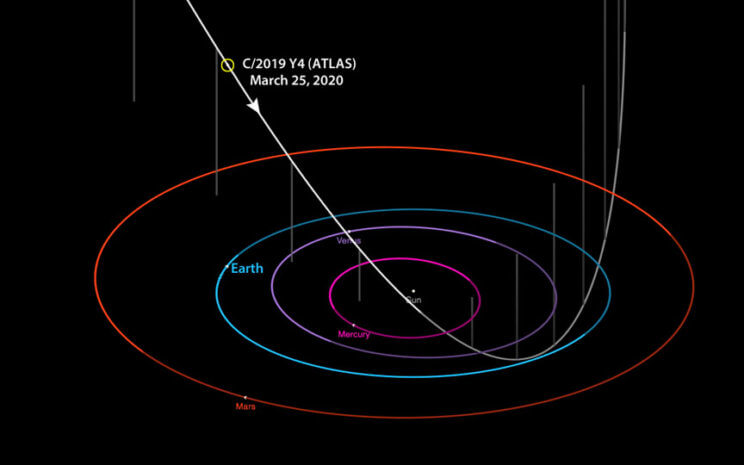English: Orbital diagram for Comet Hale-Bopp. The positions of the comet and the planets are as in April 1, 1997 (at the perihelion). The positions of the comet and the planets are as in.
Hale-Bopp is a long-periodcomet that was discovered in 1995 andthat reached perihelion in Spring, 1997. Because it was much brighterthan comets normally are when it was first discovered outside theorbit of Jupiter, there was considerable speculation that in the Spring of 1997Hale-Bopp would be a spectacular sight.

- Halley's Comet or Comet Halley, officially designated 1P/Halley, is a short-period comet visible from Earth every 75–76 years. Halley is the only known short-period comet that is regularly visible to the naked eye from Earth, and the only naked-eye comet that can appear twice in a human lifetime. Halley last appeared in the inner parts of the Solar System in 1986 and will next appear in mid.
- APOD: 2005 May 22 - The Dust and Ion Tails of Comet Hale-Bopp Explanation: In 1997, Comet Hale-Bopp's intrinsic brightness exceeded any comet since 1811. Since it peaked on the other side of the Earth's orbit, however, the comet appeared only brighter than any comet in two decades. Visible above are the two tails shed by Comet Hale-Bopp.
- Hale-Bopp was an unusually large and active comet, easily seen with the naked eye in evening skies. With a perihelion distance of 0.914 AU, Hale-Bopp’s orbit crossed inside Earth’s orbit. Hale-Bopp was believed to have an unusually large nucleus, estimated to be 27–42 km (17–26 miles) in diameter.
- ORBIT UPDATE Object: Comet Hale-Bopp (1995 O1) JPL Ref. Solution: 59 Planetary Ephemeris: DE403 No. Observations: 2158 Observation Arc: 1993 Apr 27 - 1997 Mar 29 - Residual Summary - RA Dec Total Mean.023.034.040 RMS, unweighted.773.976.880 - Corrected Elements (J2000): Solution 59 Epoch 240 = 1997 May 3.00000 Post-Fit.
But Comet Brightness is Rather Unpredictable
On the other hand, comets that arepredicted to be very bright when discovered often do not live up to theiradvanced billing(e.g. the comet Kohoutek which never grew as bright as predicted in 1974). Hale-Bopp did turn out to be a spectacular sight, certainly one of the better comets of recent years.Here is the path on the celestial sphere of the comet in 1996 and 1997.The Orbit of Hale-Bopp
The orbit of Hale-Bopp and itsposition with respect to the planetsof the inner solar system on Dec. 16, 1996, is shown in the following figure.| Comet Hale-Bopp, December 16, 1996 |
In this image the orbits are drawn to scale, but the sizes of the planet andcomet images (and the length and orientation of the comet tail) are not realistic.
At this time the comet was about 2 A.U. fromthe Sun and about 2.7 A.U. from the Earth. Thecolor blue indicates portions of orbits that are above the plane of theecliptic and green indicates portions of orbits that are below the plane of theecliptic. Notice thatHale-Bopp has an orbit that is either parabolic or highly elliptical, and thatits orbit is very far out of the plane of the ecliptic.
The Inner Solar System on April 1, 1997, with Comet Hale-Boppat perihelion. | Comet Hale-Bopp reached perihelion on April 1, 1997, at adistance of 0.91 A.U. from the Sun and 1.36 A.U. from the Earth. The imageon the left shows the relative positions of objects in the inner solar systemon that date.Here is the present position of Comet Hale-Bopp. |
Telescopic Observations of Hale-Bopp


Hale-bopp Orbit
 The following figure shows the temporal evolution of Comet Hale-Bopp from late 1995 through late 1996, asobserved by the Hubble Space Telescope.
The following figure shows the temporal evolution of Comet Hale-Bopp from late 1995 through late 1996, asobserved by the Hubble Space Telescope. 
| Hubble Space Telescope Images of Comet Hale-Bopp (1995) |
The left frame shows thecomet about 60 hours after ahuge outburst of dust; it shows a spiral structurereminescent of a water sprinklerobserved from above. The middle frame shows the comet during a more quiescentphase.The right figure shows a more recent image with atleast five jets emanating from the nucleus. (Here is an enhancedphotograph of at least 7 jets from Hale-Bopp taken at the European Southern Observatory.)
Comet Hale-bopp Orbital Period
The nucleus of the comet is located at the centerof each frame, but most of thelight observed is caused by scattered sunlight from the coma of dust emitted from the nucleus.
